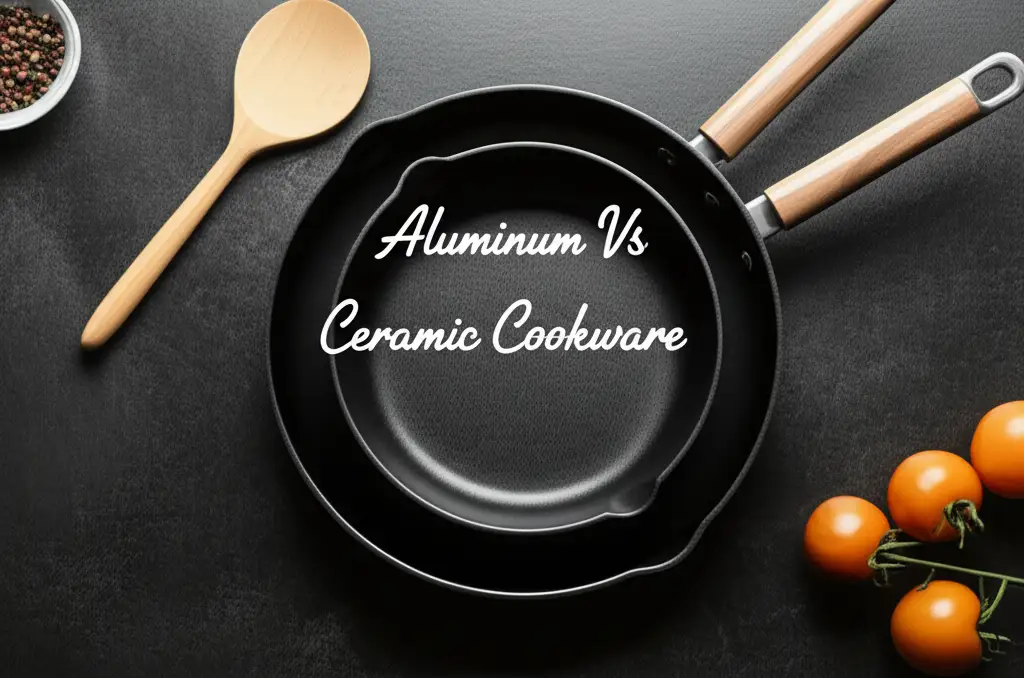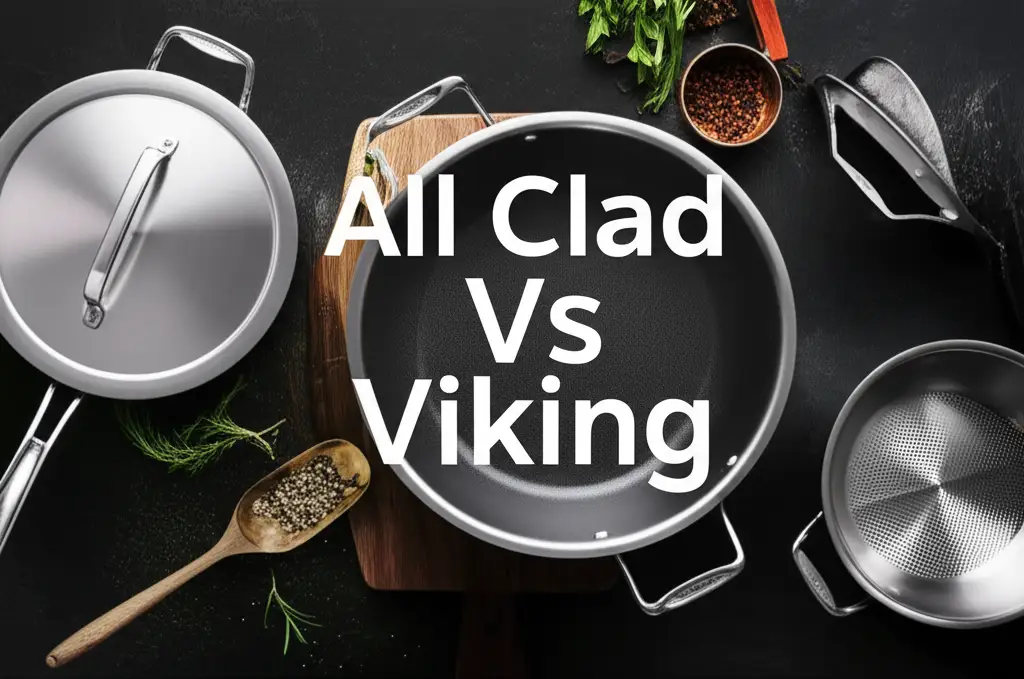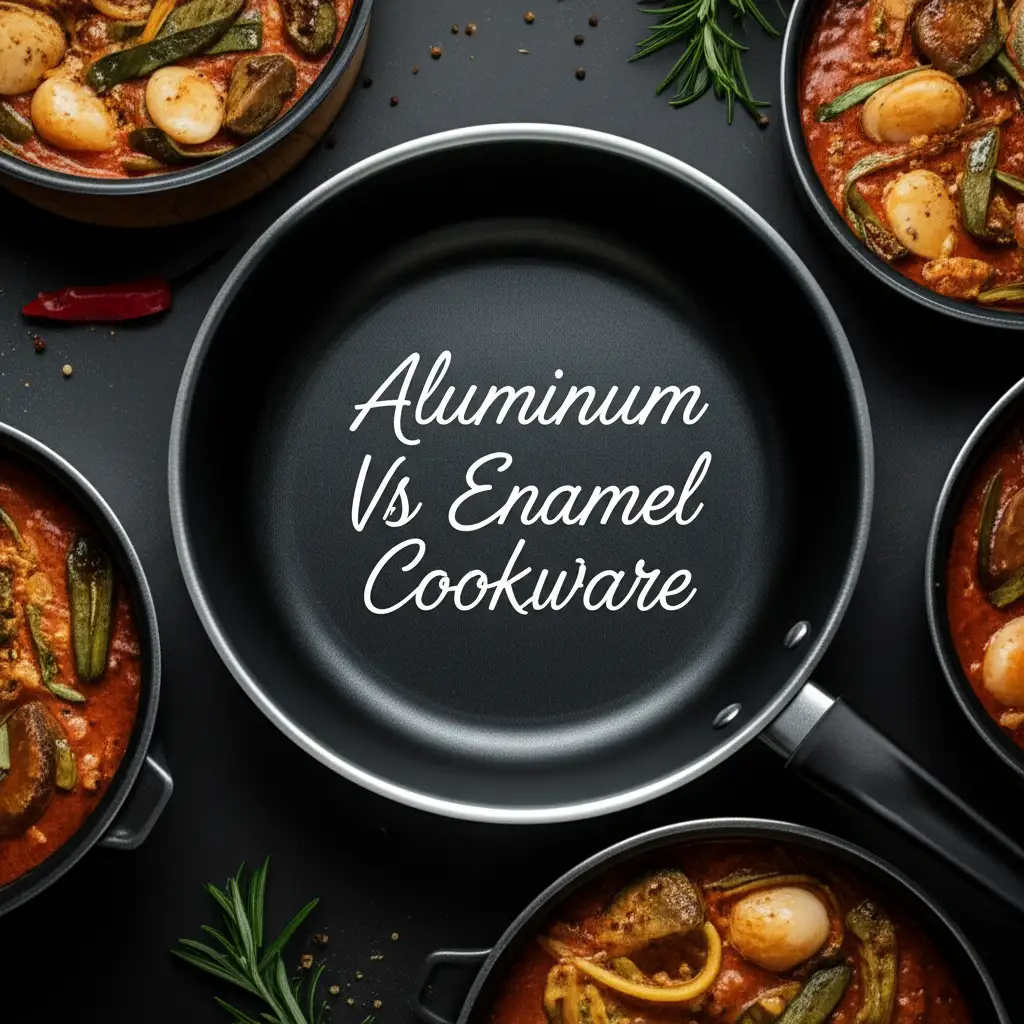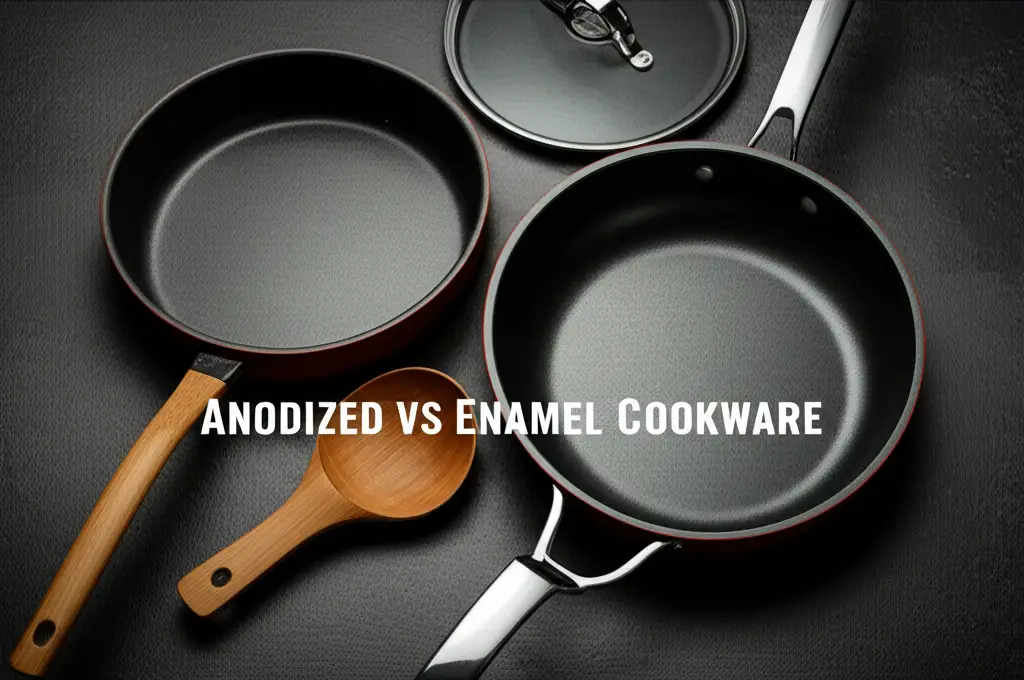· Elira Thomsen · Cookware Guides · 15 min read
All Clad Cookware D3 Vs D5
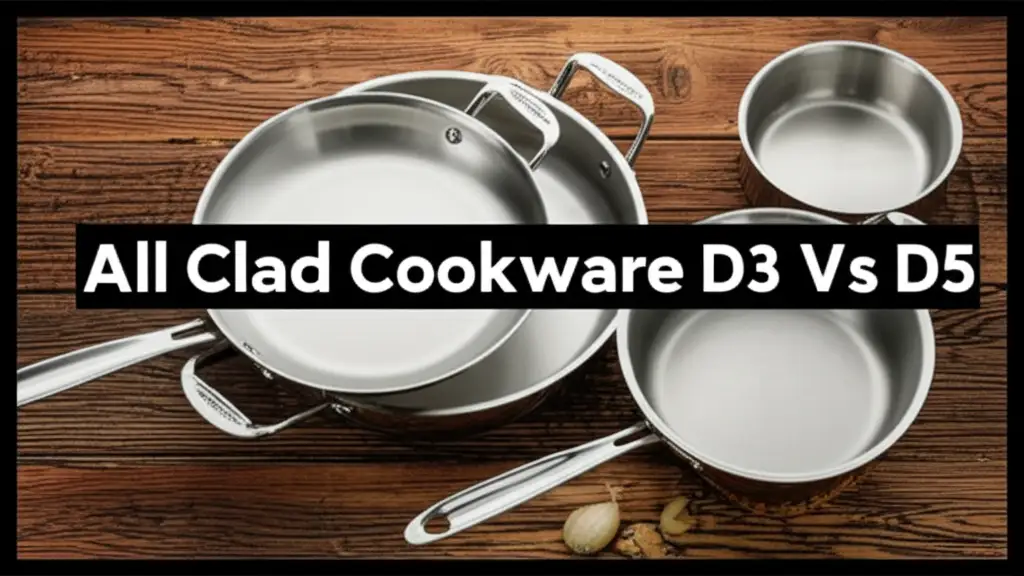
All-Clad Cookware D3 vs. D5: Which Is Right for Your Kitchen?
Choosing new cookware feels exciting. You want pots and pans that cook well and last long. When you look at high-quality options, All-Clad often comes up. They make excellent stainless steel cookware. Many home cooks wonder about All-Clad Cookware D3 vs D5. These two lines are very popular. They offer different features and benefits.
This article helps you understand the D3 and D5 differences. We will explore their construction and how they perform. You will learn about heat distribution and durability. We will also discuss cleaning and cost. My goal is to give you clear information. You can then make the best choice for your kitchen.
Takeaway
Choosing between All-Clad D3 and D5 depends on your cooking habits and priorities.
- All-Clad D3: Offers quick, even heating and responsiveness. It is a solid choice for most home cooks. D3 is lighter and often more affordable.
- All-Clad D5: Provides superior heat retention and stability. It gives you greater control over delicate dishes. D5 feels heavier and costs more.
Clear Answer to Main Query
All-Clad D3 cookware features three bonded layers for fast, even heat. All-Clad D5 cookware has five layers, adding extra aluminum and a stainless steel core. This design gives D5 slower, more stable heating and greater warp resistance.
Understanding All-Clad D3 Cookware Construction
Let’s start with All-Clad D3 cookware. This line is often called “tri-ply.” It means the cookware has three layers. These layers are bonded together. This bonding happens from the bottom of the pan up to the rim.
The D3 design uses two outer layers of stainless steel. These layers surround a thick aluminum core. Stainless steel is durable and non-reactive. It is safe for all foods. Aluminum is an excellent heat conductor. It spreads heat quickly and evenly. This three-layer design helps your food cook consistently. It prevents hot spots.
All-Clad has perfected this tri-ply bonding process. They have done this for decades. It makes the D3 line a benchmark for quality. Many chefs and home cooks love D3. They appreciate its balance of performance and weight. I find D3 pans easy to handle. They respond quickly to temperature changes on the stove. This makes them ideal for tasks like searing or sautéing.
The D3 construction provides good heat retention. It also offers excellent heat responsiveness. This means the pan heats up fast. It also cools down fast when you lower the heat. This control is useful for many cooking tasks. Whether you are making a delicate sauce or browning meat, D3 performs well. Its classic look fits any kitchen style. Many cooks have D3 sets and use them daily.
Exploring All-Clad D5 Cookware Technology
Now we move to All-Clad D5 cookware. This line represents a step up in layering. The “D5” in its name tells you it has five layers. These layers are also bonded together. This advanced construction aims for specific performance benefits.
The D5 design starts like D3. It has two outer layers of stainless steel. These layers are tough and easy to clean. Inside these layers, D5 adds more. It features two aluminum layers. Between these aluminum layers, there is another stainless steel core. This core is what makes D5 unique. It adds extra stability.
This five-layer structure changes how the pan heats. The extra stainless steel core slows down heat transfer. This sounds counter-intuitive, but it is purposeful. It creates a more stable heating surface. The pan heats up more slowly. However, it holds its temperature more consistently. This can be great for certain dishes.
I notice a difference in how D5 feels. It is heavier than D3. This extra weight comes from the additional layers. The weight also contributes to its stability. When I use a D5 pan, it feels very solid on the burner. The stable heat is perfect for slow cooking or simmering. It also helps with delicate tasks. This unique layering is a key differentiator. It shows All-Clad’s commitment to innovation.
Performance Comparison: Heat Distribution & Responsiveness
Comparing the performance of All-Clad D3 vs D5 shows clear differences. Each line has strengths. These strengths come from their unique constructions. Understanding them helps you pick the right one.
All-Clad D3 cookware offers excellent heat distribution. The aluminum core quickly spreads heat. It goes from the base across the entire cooking surface. This means fewer hot spots. Your food cooks evenly. D3 is also very responsive to temperature changes. When you turn the burner up or down, the pan reacts fast. This responsiveness is a big advantage for many cooking styles. I find it perfect for quick searing. It’s also great for sautéing vegetables where you need precise heat control. If you like to adjust heat quickly, D3 will serve you well.
All-Clad D5 cookware handles heat differently. Its five layers, especially the inner stainless steel core, create a buffer. This makes the pan heat up more slowly. However, once hot, it maintains a very stable temperature. It resists temperature fluctuations. This consistent heat is ideal for delicate sauces or slow braises. It also helps prevent scorching. While D5 is less responsive to quick heat changes, its stability is unmatched. For cooking that benefits from consistent, gentle heat, D5 shines. Think of making a perfect risotto. The stable heat of D5 helps maintain the right simmer.
When comparing kitchen tools, we often look at how different designs impact function. Just as an 8-inch chef knife vs 10-inch chef knife offers different leverage, D3 and D5 offer different thermal dynamics. D3’s quickness is great for active cooking. D5’s stability is perfect for sustained heat. Your cooking style dictates which is better. For example, if you often use high heat for quick searing, D3 might feel more natural. If you simmer soups or stews for hours, D5’s stability becomes a true asset. Both types manage heat well. Their approach to heat management differs.
Durability and Weight: D3 vs. D5 Feel
The physical characteristics of All-Clad D3 vs D5 are quite distinct. These differences affect how the pans feel to use. They also impact their long-term durability. Both lines are known for being very tough.
All-Clad D3 cookware is incredibly durable. Its tri-ply construction is robust. The stainless steel exterior resists dents and scratches. It stands up to heavy use in busy kitchens. D3 pans are often lighter than D5 pans. This lighter weight makes them easier to handle. I find this helpful when lifting a full pot of pasta. It is also easier to toss ingredients in a sauté pan. The balance feels good in your hand. Despite being lighter, D3 pans are not flimsy. They hold their shape and perform consistently. Many D3 sets last for decades with proper care. My own D3 pieces look almost new after years of use.
All-Clad D5 cookware has an even more substantial feel. The extra two layers add significant weight. This makes D5 pans noticeably heavier than D3 pans of the same size. The increased mass contributes to its incredible stability on the stovetop. It also adds to its warp resistance. The five layers make D5 extremely robust. These pans are built to withstand very high heat. They also handle constant use without warping. The weight can be a factor for some cooks. If you have wrist issues, D3 might be more comfortable. However, the heft of D5 gives a feeling of extreme quality. It feels like a serious piece of equipment.
The increased layers in D5 also contribute to its overall resilience. It has a greater ability to withstand thermal shock. This means going from hot to cold without damage is less likely. Both D3 and D5 are built to last a lifetime. This is a common feature among high-quality kitchen investments, similar to how a good 6-inch vs 8-inch chef knife is designed for longevity. The D5 just adds an extra layer of structural integrity. It handles harsher conditions well. You can rely on either line for years of cooking. The choice here comes down to feel and desired level of robustness.
Cleaning and Maintenance Differences
Keeping your All-Clad cookware clean is simple. Both D3 and D5 lines share similar care instructions. However, their physical differences can slightly impact the cleaning experience. Understanding these aspects helps you maintain your investment.
Both All-Clad D3 and D5 cookware are dishwasher safe. This is a big convenience for busy cooks. However, hand washing is often recommended for best results. It helps maintain the shine and extends the life of your cookware. Food usually releases easily from the stainless steel surface. For tougher stains, like burnt-on food, a stainless steel cleaner works wonders. Bar Keepers Friend is a popular choice among All-Clad owners. You just make a paste, rub it on, and rinse. This simple process keeps the pans looking new.
The main difference in cleaning stems from the weight. D3 pans are lighter. This makes them easier to lift and maneuver in the sink. Washing a large D3 stock pot feels less strenuous. You can move it around more freely. The smooth stainless steel surface on both lines means food doesn’t stick easily when cooking at proper temperatures. This aids in quick cleanup. After cooking, let the pan cool down. Then soak it if needed. Hot pan into cold water can cause warping.
D5 pans are heavier. This added weight can make hand washing larger pieces a bit more cumbersome. Lifting a full D5 skillet might require a bit more effort. Despite the weight, the cleaning process is identical. The non-reactive stainless steel surfaces resist staining. They do not absorb odors. This ensures your food always tastes fresh. Both lines maintain their beauty with simple care. Proper maintenance ensures your All-Clad D3 vs D5 cookware performs optimally for many years. It’s a testament to their build quality.
Price Point and Value Proposition
When considering an investment in high-quality cookware, price is a major factor. All-Clad cookware is premium. Both D3 and D5 lines reflect this quality in their pricing. However, there is a clear difference between the two. This difference influences their value proposition.
All-Clad D3 cookware is generally more affordable than D5. It still represents a significant investment. You are paying for top-tier materials and American craftsmanship. The D3 line offers exceptional performance for its price. It provides fast, even heating and good responsiveness. This makes it a great value for many home cooks. It is often the entry point for those wanting All-Clad quality. For everyday cooking tasks, D3 delivers professional results. My D3 pieces have certainly earned their keep. They perform consistently, year after year.
All-Clad D5 cookware comes at a higher price point. The increased cost reflects its more complex five-layer construction. It also reflects the unique benefits it offers. These benefits include superior heat stability and enhanced warp resistance. For some cooks, these advantages justify the extra expense. If you value extreme consistency and a very stable cooking surface, D5 offers unique value. It is for those who seek the highest level of precision. They also want robustness in their cookware. The added weight and slower, more even heating are premium features. They serve specific cooking needs.
The value proposition depends on your needs. If you want excellent all-around performance without the highest price tag, D3 is a fantastic choice. It will meet the demands of most home kitchens. If you are a serious cook, or you often cook delicate dishes, D5 could be worth the splurge. The difference in cost between D3 and D5 sets can be substantial. Sometimes, a single D5 pan can cost as much as a small D3 set. Consider your budget and your cooking style. Both are built to last a lifetime. They offer great long-term value. This is similar to how opting for a specific kitchen appliance like a new Breville juicer vs Ninja blender requires weighing unique features against cost. Each All-Clad line offers lasting performance.
Choosing Between D3 and D5: Your Cooking Style
Deciding between All-Clad D3 vs D5 ultimately comes down to your personal cooking style. Both lines are excellent. They simply cater to different preferences and needs. Think about how you cook most often. Consider the types of dishes you prepare regularly.
If you are a versatile cook, All-Clad D3 is an outstanding choice. It excels at a wide range of cooking tasks. Its quick heating and responsiveness are perfect for searing meats. It’s also great for sautéing vegetables. I find D3 ideal for everyday meals. It handles high heat well. It gives you precise control when you need to adjust temperatures fast. D3 is also lighter. This makes it easier to handle, especially for larger pots or pans. If you love quick stir-fries or pan sauces, D3 responds immediately to your commands. It’s a workhorse for the active home chef.
If you prioritize consistent, stable heat, All-Clad D5 is better. Its five-layer design provides superior temperature maintenance. This makes it ideal for slow cooking. It shines when simmering delicate sauces. It’s also perfect for recipes that require very even heat distribution over a longer period. The D5 pans are heavier. This weight means less chance of warping. It also feels very solid on the stovetop. If you frequently make custards, gravies, or long-simmered stews, D5 reduces the risk of scorching. It creates a very forgiving cooking environment. This level of consistency is invaluable for certain dishes.
Consider the tools you use most often in your kitchen. Just as deciding on an air fryer vs air roast setting depends on your desired outcome, your cookware choice depends on your cooking goals. Do you prefer rapid changes or steady, even temperatures? Do you need a lighter pan for easy handling or a heavier one for ultimate stability? My personal preference leans towards D3 for its versatility and responsiveness. However, if I were regularly making delicate sauces or deep-frying, D5’s stability would be very appealing. Both lines represent a significant upgrade for any kitchen.
Factors to Consider
- Responsiveness: D3 heats up and cools down faster.
- Heat Stability: D5 holds temperature more consistently.
- Weight: D3 is lighter, D5 is heavier.
- Price: D3 is generally more affordable.
- Cooking Tasks: D3 for searing/sautéing, D5 for simmering/delicate work.
FAQ Section
Is All-Clad D5 really better than D3?
“Better” depends on your cooking style. All-Clad D5 offers enhanced heat stability due to its five layers. This means slower heating but more consistent temperatures. All-Clad D3 heats faster and is more responsive. It uses three layers. Neither is universally “better.” Each serves different cooking preferences. D5 might be preferred for delicate sauces, while D3 excels at searing.
Can All-Clad D3 and D5 go in the oven?
Yes, both All-Clad D3 and D5 cookware are oven safe. They can withstand very high oven temperatures, typically up to 600°F (315°C). This makes them versatile for finishing dishes in the oven. You can move them from stovetop to oven seamlessly. Always check the specific product manual for exact temperature limits.
What is the lifespan of All-Clad cookware?
All-Clad cookware, including D3 and D5 lines, is built to last a lifetime. They come with a limited lifetime warranty. With proper care and maintenance, these pans can be passed down through generations. Their robust construction resists warping, pitting, and corrosion. This makes them a durable kitchen investment.
Is All-Clad D5 worth the extra cost?
The extra cost of All-Clad D5 is worth it for specific needs. If you prioritize maximum heat stability, warp resistance, and superior heat retention, D5 delivers. It benefits cooks who often prepare delicate foods or need sustained, even heat. For general cooking, D3 offers excellent value at a lower price point. Your cooking habits determine its worth.
What is the difference in appearance between D3 and D5 stainless steel?
Both D3 and D5 feature a brushed stainless steel exterior. D3 usually has polished handles. D5 often features a brushed finish on both the body and handles. This gives D5 a more uniform, slightly industrial look. The cooking surface itself is identical high-quality stainless steel on both lines.
Does All-Clad D5 weigh significantly more than D3?
Yes, All-Clad D5 cookware does weigh significantly more than comparable D3 pieces. The additional two layers, especially the inner stainless steel layer, add considerable mass. This extra weight contributes to D5’s enhanced stability and heat retention. It is a noticeable difference when you lift the pans.
Conclusion
Choosing between All-Clad Cookware D3 vs D5 is a thoughtful decision. Both lines represent the pinnacle of stainless steel cookware. They offer exceptional quality and performance. The D3 line is your go-to for speed and responsiveness. Its three-layer design heats quickly and evenly. It is also lighter and often more budget-friendly. This makes D3 a fantastic choice for most home cooks. I love its versatility for my daily cooking.
The D5 line offers a different experience. Its five layers provide superior heat stability. It heats slower but holds temperature incredibly well. D5 feels heavier and more robust. It is perfect for delicate cooking tasks. It also resists warping more effectively. This makes it a serious tool for serious cooks. Your cooking style is the ultimate guide here. Consider what kind of heat control you need most.
No matter your choice, All-Clad cookware is a lasting investment. It will enhance your cooking experience for many years. Think about your preferred cooking methods. Weigh the benefits of fast response versus stable heat. Pick the line that best suits your kitchen adventures. Investing in quality cookware makes every meal better. Elevate your cooking with All-Clad.


